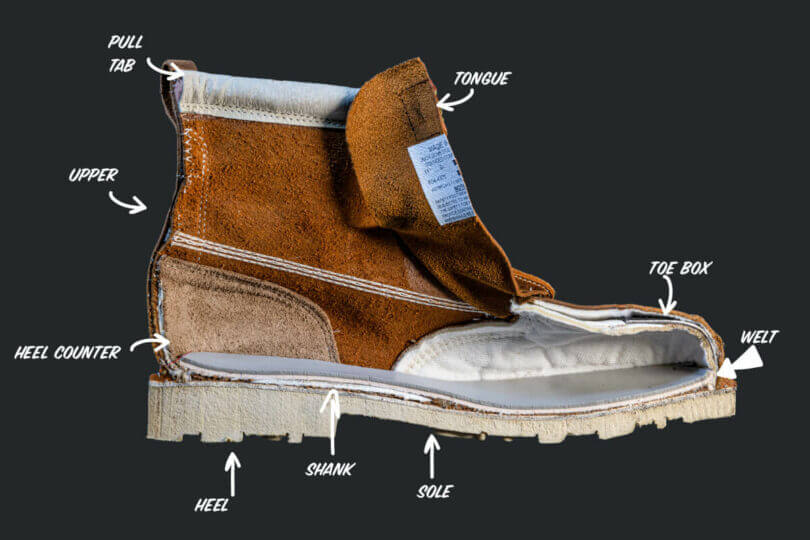If you’re buying your first pair of work boots, it’s important to know how boots should fit so you don’t end up with painful sores or worse, have an accident. We’ll explain how to measure your boot size and cover boot anatomy (so you know what parts we’re talking about) when looking at the Thorogood Boot Sizing Guide below.
How to Size Work Boots
Not all boot sizes are the same but figuring out your Thorogood boot sizing is simple. First, you’ll need a measuring tape or ruler. It’ll help if you have a piece of paper you can mark with a pencil. You’ll want to draw a line at your heel and at your longest toe, then measure between the lines in inches.
Remember to measure both feet! It’s quite common to have slight variations in foot size and one boot may end up feeling tighter than the other.
Now that you know your foot length, compare your measurements to our Thorogood Boot Sizing Guide below and remember to always size up to account for socks!
How Should Boots Fit?
Sizing work boots can be tricky since everybody has a personal preference. Some people like to be able to wear thick socks, especially in cold weather, and some like to wear thin socks, which can make work boots feel too loose. Insoles can provide additional arch support and comfort, but if your boots are already on the small side, you may find your feet too cramped with insoles. As a guide, you should be able to have a finger’s width distance between your longest toe and the end of the shoe, and your heel should stay secure in your work boots as you walk. Having resistance is normal and once your work boots break in, they’ll give a little and feel more comfortable.
How to Tell if Boots Are Too Big?
You can tell if your boots are too big if your heel comes up as you step forward. Wearing too big of boots can end up giving you blisters and can be quite uncomfortable. Your toes should have about half an inch of room in front of them so your toes aren’t completely pressed against the front of your boots, but they shouldn’t slide forward as you walk and hit the front of the toecap. Having too large boots can also increase your risk of tripping and can be clumsy to work in. Your work boots are meant to protect you on the job, not cause accidents!
Boot Anatomy
Knowing what part of the boot we’re talking about when measuring and choosing work boots is important. Here are the main parts of work boot anatomy:
- Sole – the sole is designed to give you traction, slip resistance, protection, and stability.
- Shank – the shank provides arch support while also protecting your feet against punctures and sharp objects.
- Upper – the upper part of a work boot is made to protect and insulate your feet, connecting the toe box to the rest of your boot.
- Heel – Your occupation and how you’ll use the boots determines whether you need a raised heel or whether you can work with a wedge heel.
- Eyelet – the eyelets are helpful for different knot styles and keep your laces in place as well as provide an anti-corrosive area to prevent your laces from shredding.
- Pull tab – the pull tab is designed to help you easily put on your work boots and can even be used with a boot hook if needed.
- Toe box – the toe box maintains the structure of the toe and is the area where safety toes are implemented, such as steel toes and composite toes.
- Tongue – the tongue protects debris from sliding into your boot and allows flexibility as you walk, bend, and move in your boots.
- Welt – the area where the upper part of the boot attaches to the sole. Higher quality materials used on the welt will determine the lifespan of the boots.
- Vamp – the vamp creates the fit for the boot.
- Shoelace Aglet – the plastic tip of the laces that you never knew the name for.
- Heel counter – the shape of the heel counter is used to keep the foot in place and prevent your foot from slipping in your work boots with increased heel and arch support.

Thorogood Boot Sizing Guide
All boots are created differently so you’ll want to refer to the Thorogood Boot Sizing Guide if you haven’t purchased a pair of our work boots in the past and aren’t confident in what size you’ll need. Be sure to try on a couple pairs and choose your work boot preference accordingly.
